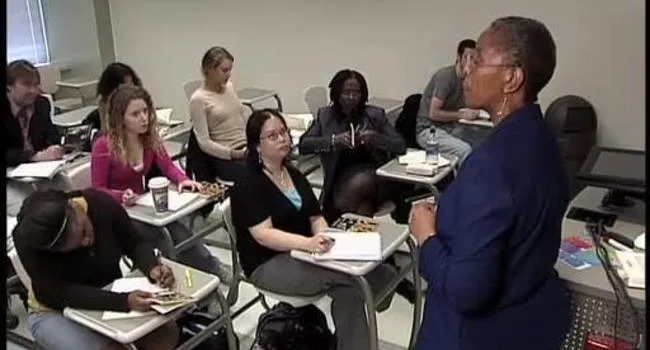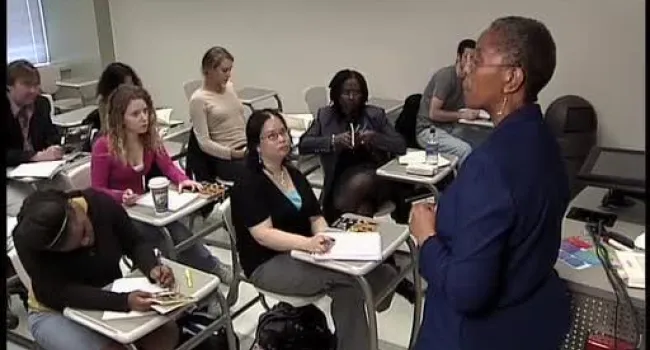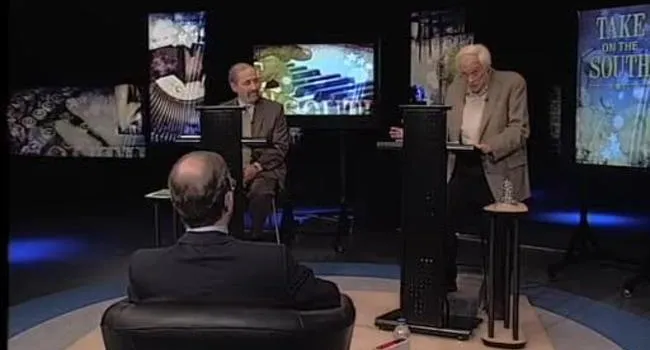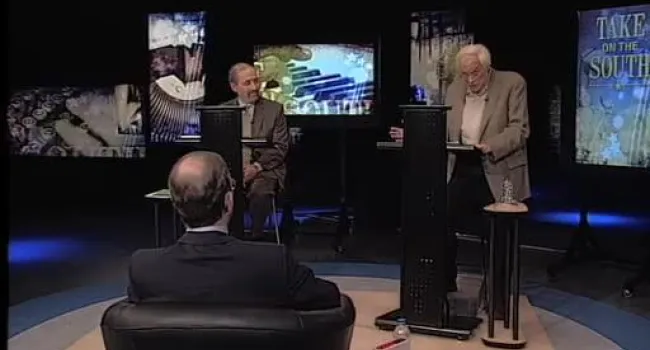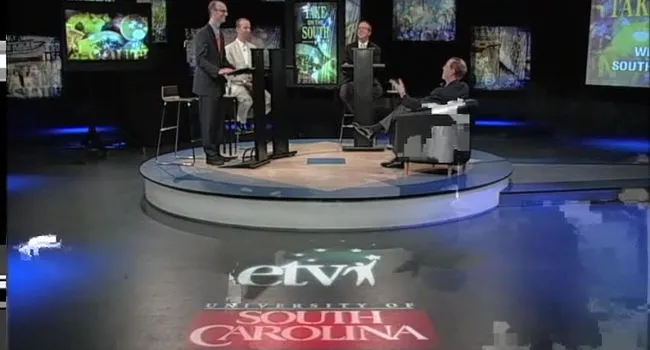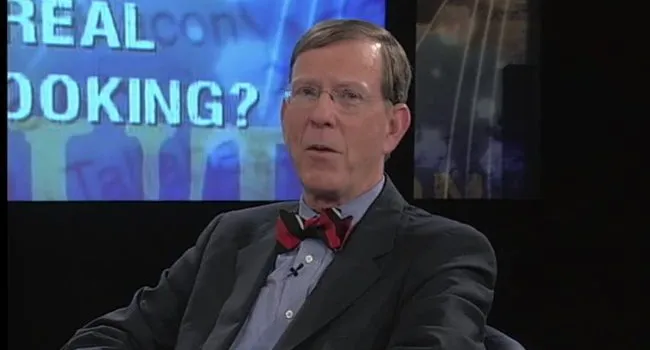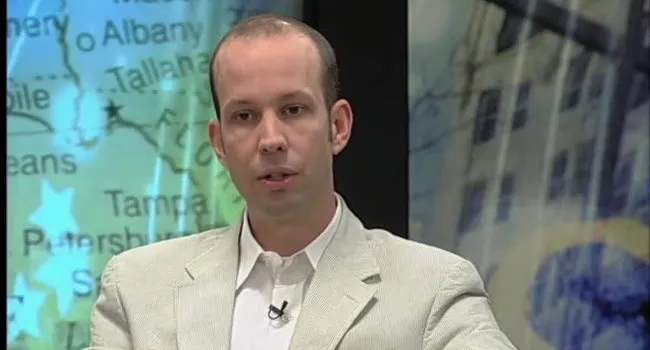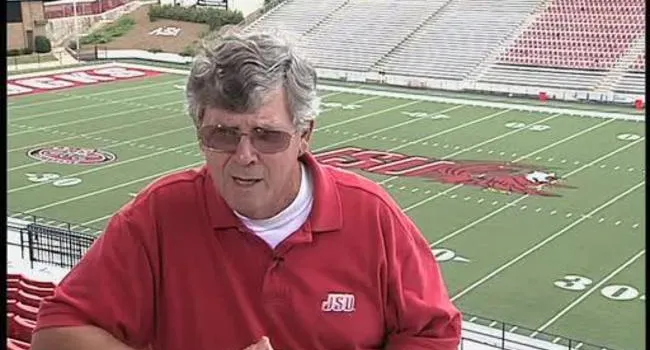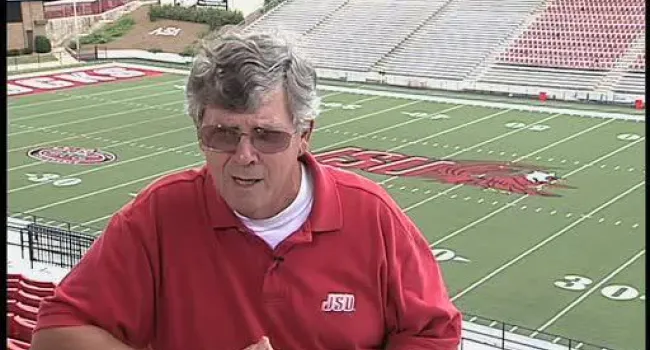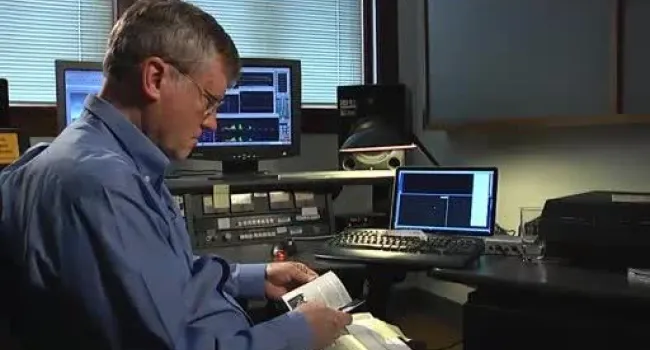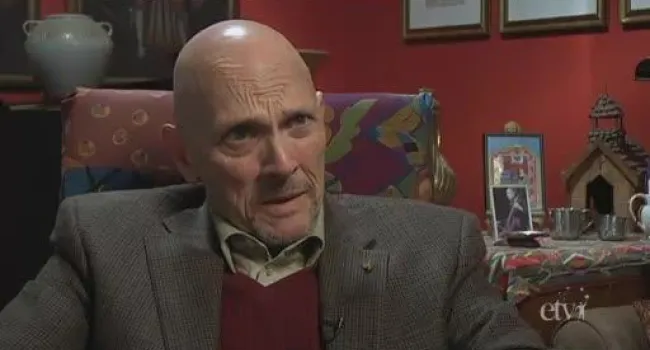00:00
(Walter Edgar)
This program is funded
00:02
by a grant from
the Watson-Brown Foundation.
00:44
Greetings,
ladies and gentlemen.
00:46
I'm Walter Edgar,
director
00:47
of the Institute
for Southern Studies
00:49
at the University
of South Carolina
00:51
and your moderator
for this series,
00:53
"Take on the South."
00:55
In "Take
on the South,"
00:57
distinguished scholars present
differing positions, or takes,
01:00
on a variety of issues that have
been identified with the region
01:04
over the course
of our nation's history.
01:07
Sphinxlike, varied,
and deeply textured,
01:10
the American South means
many things to many people.
01:14
It offers an unusually
compelling region to debate,
01:17
and potential subjects
are numerous:
01:22
economic development,
and slavery.
01:25
Today's topic
is politics.
01:27
The debate: Must
a candidate carry the South
01:30
in order to win
the Presidency?
01:32
In other words, does
the road to the White House
01:36
run through the South?
01:38
Today, the term debate
surely ranks
01:42
as one of the most overused
and misunderstood words.
01:46
Before television, debate meant
a serious discussion of issues
01:50
by individuals
of opposing points of view.
01:53
The discussion could be
either written or oral.
01:56
Debaters used reason, fact,
and cultural tradition
01:59
to persuade
their audience.
02:01
With "Take
on the South,"
02:03
we aim to restore the meaning
of the word...and its spirit.
02:08
Our nation's history is peppered
with significant debates.
02:14
the Constitutional
Convention in 1787.
02:16
The delegates
debated whether or not
02:18
the ineffective Articles of
Confederation should be amended,
02:21
whether the country
should adopt a new constitution,
02:24
and whether the states
should be represented
02:27
proportionally or equally
in the national government.
02:30
In 1791, Thomas Jefferson
and Alexander Hamilton
02:34
argued over the creation of the
First Bank of the United States.
02:38
In 1830, Senators Robert Y.
Hayne of South Carolina
02:43
and Daniel Webster
of Massachusetts
02:45
debated the issue
of state sovereignty
02:47
and the nature
of the union.
02:50
Easily the best-known political
debate of the 19th century
02:53
was between Stephen Douglas
and Abraham Lincoln.
02:57
In 1960,
the televised debates
02:59
between Richard Nixon
and John Kennedy
03:02
changed the meaning
of the term debate.
03:05
Nixon's five o'clock shadow
and perspiring upper lip
03:09
contrasted powerfully with
Kennedy's boyish good looks.
03:13
The individuals' appearances
attracted more attention
03:16
than their position on
education and the minimum wage.
03:20
Substance, alas, was
subordinated to the trivial.
03:24
Just consider what passes
for debate in the 21st century.
03:29
With "Take
on the South,"
03:31
we aim to restore the
distinguished lineage of debate,
03:35
rendering it meaningful,
relevant, and substantive.
03:38
The purpose of
"Take on the South"
03:41
is to present informed positions
to you the audience
03:45
to stimulate
discussion and thought.
03:47
As Thomas Jefferson
wrote in 1815,
03:50
"Difference of opinion
leads to enquiry,
03:54
and enquiry to truth."
03:57
Now let's meet the scholars
who will debate our topic.
04:04
Herbert S. Autrey
Professor of Political Science
04:06
at Rice University
in Houston, Texas.
04:09
His field
is American politics,
04:11
with special attention
to the changing politics
04:13
of the American South.
04:15
In partnership
with his twin brother,
04:17
Merle Black
of Emory University,
04:19
he has written three books
for Harvard University Press
04:22
on Southern politics.
04:24
His new book,
coauthored with Merle Black,
04:27
is "Divided America:
04:29
The Ferocious Power Struggle
in American Politics.
04:32
This book was selected
by "Choice" magazine in 2008
04:35
as an Outstanding
Academic Book.
04:38
Dr. Thomas F. Schaller
04:40
is associate professor
of political science
04:42
at the University of Maryland,
Baltimore County,
04:44
in Baltimore, Maryland.
04:46
He teaches courses
in American government,
04:48
including
the U.S. Presidency,
04:50
Congress,
and interest group behavior.
04:52
He is the author
of "Whistling Past Dixie:
04:55
How Democrats Can Win
Without the South."
04:58
A twice-monthly
political columnist
05:00
for "The Baltimore Sun,"
05:02
he gives lectures around the
world about American politics
05:05
on behalf
of the U.S. State Department.
05:09
Welcome, Dr. Black,
Dr. Schaller.
05:11
The rules for this debate
are simple.
05:13
Each scholar will have 18
minutes to present his position.
05:17
Then each one
will have the opportunity
05:19
to ask the other a question, no
longer than a minute in length,
05:23
and the other will have
five minutes to respond.
05:26
For timing purposes, I'll signal
when there's one minute left
05:29
and when time is up.
05:31
To decide who presents first
and who asks the first question,
05:35
earlier today we flipped a coin,
and a special coin it was:
05:39
the official coin
of "Take on the South."
05:41
Heads features
the state seal of South Carolina
05:44
and the state's
tricentennial.
05:46
Tails shows
a Lowcountry scene
05:48
with a sailing ship
and Indian dugout canoe.
05:51
As a result of the toss,
Dr. Black will present first,
05:54
and Dr. Black will also ask
the first question.
05:58
Dr. Black, does the
road to the White House
run through the South?
06:04
Good evening,
and thank you very much
06:07
for this opportunity
to come to South Carolina
06:09
and participate in
this first "Take on the South."
06:12
I think it's
entirely appropriate
06:14
that we begin this
important series with politics
06:17
because what could
possibly be more important
06:19
than trying to understand
Southern politics?
06:22
The question is, Does
a candidate for the Presidency
06:26
need to carry the South
in order to win the Presidency?
06:30
And my answer to that
is yes...
06:35
It depends
on the party.
06:38
The Republicans not only
need to carry the South,
06:42
they need
to sweep the South.
06:44
They have
no margin of error
06:46
in getting
to 270 electoral college votes,
06:49
which is what you need
at the bare minimum
06:52
to win
the White House.
06:54
So Republicans will need
every Southern state.
06:56
The Democratic Party is
in a very different position.
06:59
Once the Party of the South,
the solid Democratic South--
07:03
think Franklin D. Roosevelt,
07:05
four consecutive elections
in the New Deal period
07:07
as the high point
of that tradition.
07:10
The Democrats
have more options.
07:12
The Democrats don't need
any Southern states.
07:15
It's certainly possible for
the Democrats to get past 270
07:19
without carrying
a single Southern state,
07:22
but they'd be well advised
to try to make their job easier
07:26
by carrying
two or three.
07:28
So a very different pattern for
the parties based on the South.
07:32
Now, why is
the South important?
07:34
Let's start
with the size.
07:36
The South is the largest region
in American politics.
07:40
In "Divided America," the book
my brother Merle and I wrote,
07:44
we divide the nation
into five regions.
07:46
The South
is by far the biggest.
07:49
The 11-state South
of the Confederacy,
07:51
which is how
we define the South--
07:53
we've written now four books
using that definition,
07:56
and we're not gonna change
our definition at this point.
07:59
But that's
the classic definition.
08:02
The 11 states
of the Confederacy
08:05
control 153
electoral votes.
08:09
Two hundred and seventy
are needed for victory.
08:12
So 28% of America's
electoral votes
08:14
are in the 11
Southern states.
08:16
If a party
can sweep the South,
08:19
as the Republicans have in the
last two Presidential elections,
08:22
that means they are
well past the midway point
08:25
for winning
the White House.
08:27
Obviously, no party
wins the Presidency
08:30
simply by carrying
the South,
08:32
but the size of the South
is very important.
08:35
The South gets bigger
every ten years.
08:37
When the new census
is taken,
08:39
it will have more than 153
electoral votes
08:42
in the next Presidential
election following 2008.
08:46
Now, let's take
the parties one by one
08:49
and look at the options
and the strategic objectives
08:54
We'll start
with the Republican Party.
08:57
Republicans have a very
straightforward strategic goal.
09:01
They need carry every one
of the 11 Southern states,
09:06
from Virginia through Florida
over to Texas,
09:09
and they need do that because
we are well past the 1980s.
09:17
The Republicans won three
consecutive national landslides.
09:22
Ronald Reagan in 1980,
Ronald Reagan again in 1984,
09:26
and then George Bush
the first in 1988.
09:31
These were
national landslides.
09:33
The Republicans triumphed in
every part of the United States.
09:37
They were relatively less
successful in the Northeast,
09:40
but very successful
across the nation.
09:42
Those days are gone;
they're not coming back.
09:46
So whereas in the 1980s,
the Republicans had the luxury
09:50
of putting together
many different combinations
09:57
And in the last two
Presidential elections--
10:00
they have been
among the closest ever
10:02
in the history
of the United States--
10:05
the Republican Party
has succeeded narrowly
10:08
with an implicit
sectional strategy.
10:12
Now, political parties
generally
10:14
don't talk about
their strategies.
10:19
But looking
at what happened,
10:21
if we look at the structure
of the Republican victory
10:25
in 2004 and 2000,
very narrow victories,
10:28
what we see is
the Republicans carrying
10:30
every one
of the Southern states,
10:33
so 100% of the South.
10:35
The objective
is to get past 270.
10:38
So the question is,
if we at this point
just divide the nation
10:42
into the South
and everything else--
10:44
and for convenience, let's
call everything else the North.
10:47
Let's just keep the
Confederate states as the South,
10:51
and everything else
becomes the North.
10:53
I think that's
a realistic way to look
10:55
at American sectionalism
over time.
10:57
So what's
the consequence
10:59
of the Republicans
carrying the entire South?
11:02
What's their
Northern target?
11:03
What share of the Northern
electoral vote must they win
11:07
to combine
with 100% of the South
11:09
in order to get past
50% in the nation?
11:12
It's a very straightforward
calculation.
11:14
Everything
we're gonna talk about
11:16
is based on adding,
subtracting, and dividing.
11:18
We don't even get
into multiplication.
11:20
Don't have to get
past the sixth grade
11:23
to understand the basic concepts
involved here.
11:25
What we have now
for the Republicans
as a Northern target,
11:29
if they are completely
successful in the South,
11:32
is 30% of the electoral vote
in the rest of the nation.
11:36
A hundred percent of the South,
thirty percent of the North
11:40
equals 50.1% of the nation's
electoral votes, a victory.
11:45
Now, we might say
that's a pretty low threshold.
11:49
Only 30% of the
Northern vote is needed.
11:52
And yet...the Republicans
have had great difficulty
11:56
in reaching
that Northern threshold.
11:59
Ronald Reagan
did not.
12:01
Bush in 1988
did not.
12:03
But as I said,
those days are long gone.
12:07
Let's look
just at what happened
12:09
in the 2004
Presidential election,
12:11
our most recent
election.
12:13
George W. Bush,
running for reelection,
12:16
carried
every Southern state.
12:18
Most of them
were not competitive.
12:20
Most of them were
really not contested at all.
12:23
He needed 30% of the entire
Northern electoral vote.
12:30
a pretty narrow margin
outside the South.
12:35
And that produced a national
electoral college victory
12:38
for the Republicans of 53%.
12:42
So 100% of the South,
35% of the North
12:46
equals a pretty decisive
Presidential victory.
12:51
The comparison that
I think is relevant here
12:55
from a historical
standpoint
12:57
is that the Republicans'
current sectional strategy
13:02
resembles the way
in which Franklin D. Roosevelt,
13:05
in the Great Depression,
created the New Deal,
13:09
had such easy
Presidential victories.
13:12
Roosevelt never disturbed
the solid Democratic South.
13:18
He never moved, for example,
on any real disturbance
13:21
of Southern segregated
race relations
13:24
because that would certainly
have disrupted the solid South.
13:27
And as a result,
he won the Southern states
13:30
not only without
any serious effort,
13:33
but without any use
of campaign resources.
13:36
Roosevelt never had
to campaign in the South.
13:38
didn't spend a nickel,
I suspect, in the entire South.
13:42
Starts out
with that huge advantage.
13:44
Then, if FDR carries
all the 11 Southern states,
13:47
what does he need
in the North?
13:50
At that time, the South's
not as big as it is today,
13:54
so his Northern target, Franklin
D. Roosevelt's Northern target,
13:57
was not 30%, but 33%.
14:03
Franklin D. Roosevelt, former
governor of New York State,
14:06
could he possibly win
14:08
1/3 of the electoral vote
outside of the Southern states?
14:12
Folks, he can do that
before breakfast.
14:15
That ensured four
consecutive landslides
14:18
for the Democratic Party
back in the 1930s.
14:21
The advantage of Roosevelt
for a solid South
14:24
was you don't need
a majority of the electoral
vote outside the South.
14:28
You don't even need
more than a third.
14:31
Easy Presidential
victories,
14:33
and the only time
in American history
14:35
when the
Democratic Party
14:37
won five consecutive
Presidential elections.
14:41
Now, for
the Democrats,
14:44
the Democrats
have more options.
14:48
The Democrats have
a harder way to achieve victory
14:55
The harder way is to do it
without any Southern state.
15:01
Now, for the Democrats,
if you win 0%
15:04
of the electoral vote
15:08
what's the
Northern target?
15:11
Turns out--a very
straightforward calculation--
15:14
you have to get
all 270 electoral votes
15:19
The magic formula is 70%
of electoral vote in the North.
15:25
Again, it
might seem high.
15:27
The fact is, the Democrats
came within a few points
15:31
of achieving that
in both 2000 and 2004.
15:35
So the other big story
of American politics
15:38
is the Democratic comeback
after the 1980s
15:42
outside
the American South.
15:44
Franklin D. Roosevelt
didn't need
15:47
a majority of the
Northern electoral votes.
15:49
The modern
Democratic Party does.
15:52
The great advantage
of the North
15:55
is the North contains
72% of the electoral
votes in the nation.
16:00
The advantage of the North
compared to the South
16:03
is huge size,
much larger size.
16:06
Hence, perfectly
possible--
16:08
not the easiest way to do it,
but certainly possible--
16:11
for the Democrats to win
without any Southern states.
16:16
In 2004, narrow
Democratic defeat.
16:20
John Kerry, Massachusetts,
Northern liberal Democrat,
16:24
has no success
in Southern states in 2004,
16:29
but Kerry wins
enough states in the North
16:33
to accumulate 65%
of the total electoral vote
16:40
So John Kerry came within five
points of a national victory
16:44
based on his
performance in 2004.
16:49
The Democrats' strategy,
16:53
if it's gonna be done
without the South,
16:56
actually resembles
the old Republican Party.
17:00
This is
the Lincoln strategy.
17:02
It's the Lincoln strategy,
starting in 1860.
17:04
Write off the South;
unify the North.
17:07
The big advantage
of the North is its size.
17:12
and from the Civil War
until the Great Depression,
17:16
the Republicans do
practically all of the winning
17:19
in Presidential elections
17:21
based on a strategy that
explicitly wrote off the South,
17:25
but could be executed
17:27
in the vast majority
of Presidential elections
17:30
because of
the huge size of the North.
17:33
That is the position
in which the Democrats
now find themselves
17:37
if they have no success
in a Southern state.
17:40
Now, as I say, that's
the harder way to win,
17:43
but it is not
unrealistic.
17:46
It is
very, very feasible
17:48
for the Democrats
to win the White House
17:51
without going
through the South.
17:53
Not the easiest way to do it,
but it could be done.
17:57
Now, the easier way
to do it
18:00
is the way that Bill Clinton
did it in 1992 and 1996.
18:03
What Bill Clinton did
18:05
was make no attempt
to carry every Southern state,
18:10
but instead invest
in a few Southern states.
18:14
He did this most dramatically
by selecting as his running mate
18:19
Democratic senator
from Tennessee Al Gore.
18:22
So he had an all-Southern
ticket in 1992--
18:27
Clinton from Arkansas,
Gore from Tennessee--
18:29
and, as a result,
Clinton is able to do
very well in the North,
18:34
but his strategic objective is
not to carry the entire South,
18:38
but rather
to divide it.
18:40
If he can
divide it,
18:42
then that Northern target
of 70% goes down,
18:45
so it becomes easier
to execute that strategy.
18:49
The other historical example
that this resembles
18:52
is the Republican Party when
it first actively participated
18:56
in Southern
Presidential politics
18:58
under Dwight D. Eisenhower
back in the 1950s.
19:01
Dwight Eisenhower did not try
to carry all Southern states.
19:05
He said we're gonna pick a few
states that seem most promising,
19:09
states like
Texas, Florida, Virginia.
19:11
We're gonna concentrate
our efforts there.
19:13
What do
we want to do?
19:15
We want to prevent
a solid Democratic South.
19:18
If we can do that,
then we can bring
19:21
our historical Republican base
outside the South into play.
19:25
And Eisenhower wins
two landslide elections
19:30
So the easier way for
the Democrats, it seems to me,
19:33
is to try
to divide the South.
19:38
two or three Southern states
from the Republicans,
19:41
states like Florida, the
biggest of the Southern states
19:44
that might be competitive,
27 electoral votes;
19:48
Virginia;
perhaps North Carolina.
19:50
To the extent that the Democrats
have any success in doing that,
19:55
then that Northern
strategic objective
19:57
of 70% of the electoral vote
goes down.
20:00
Much easier
to win a victory
20:02
and, indeed,
a more convincing victory.
20:06
Now, since
time is fleeting,
20:08
I'm gonna basically offer
one other suggestion here,
20:11
that one good way
to understand
20:13
the structure of the South
in modern Presidential politics
20:17
is to look at the South's role
in a regional analysis.
20:23
If we look
at the Republicans today
20:25
and the Democrats
across the nation,
20:28
we have two competitive
minority parties.
20:32
Neither party
is a majority party.
20:35
Republicans would have
fewer self-identified partisans
20:38
today than Democrats.
20:40
It was pretty even
four years ago.
20:42
But basically,
the Republicans
20:44
try to win
Presidential elections
20:46
by consolidating support
in the South, one region,
20:49
and the Mountain Plains,
another region.
20:51
Put those
two regions together.
20:53
Those are
the Republican strongholds.
20:55
Together, those
two regions contain
20:57
41% of the electoral vote,
not a majority.
21:01
The Democratic Party
draws its greatest strength
21:04
from two regions as well:
the Northeast, Pacific Coast.
21:07
Those two regions
put together
21:09
control 37%
of the electoral vote,
21:12
not far behind
the Republicans.
21:14
The Midwest with 22%
of the electoral vote
21:17
is America's
great swing region.
21:19
That's the one where
the upper Midwestern states
21:22
have generally
gone Democratic.
21:24
The lower Midwestern states,
in recent elections,
21:26
have generally
gone Republican.
21:28
And within
the Midwest,
21:30
Ohio is the swing state
in the swing region.
21:33
So the formula for the Democrats
to win the White House--
21:37
at least one
obvious formula--
21:39
is carry all the states that the
Democrats carried four years ago
21:45
That's
well past 270.
21:47
Democrats
have just been
21:49
one big state away
from national victory,
21:51
or two or three
other states.
21:53
So as we look
at 2008,
21:57
both parties
are trying desperately
21:59
to try to consolidate
their regional strongholds
22:02
and, at the same time,
22:04
identify states in the other
party's regional strongholds
22:07
that would be
ripe for conversion,
22:09
states where recent elections
have been very competitive.
22:11
So Democrats
are looking at states
22:14
like Colorado
in the Mountain Plains,
22:16
New Mexico
and perhaps Nevada,
22:18
as well as Florida, Virginia,
and perhaps North Carolina
22:25
All the Democrats need to do
is a little bit better
22:29
either in the Midwest
or the Mountain Plains
or Southern states,
22:33
and that's
a victory.
22:35
So to bring this
to a conclusion
22:38
for the question of the hour,
which is,
22:41
"Does the road to the White
House run through the South?"
22:45
again my answer
is yes and no.
22:47
For the Republicans,
it absolutely must.
22:49
To succeed, they have
to carry all 11 Southern states.
22:53
I can't see
a road to victory
22:55
that does not go through
those Southern states.
22:58
They have to do
other things as well.
23:03
the Democrats
have more options.
23:06
They don't
need to carry
23:08
more than a couple
of Southern states.
23:11
And if they can carry
a Virginia or a Florida
23:14
or a North Carolina
or some combination,
23:16
I think they will be
in great shape
23:19
to recapture
the White House.
23:23
in order to win
without any Southern states,
23:26
that's a very doable
proposition too.
23:28
All they have to do
is a little bit better
23:31
in the Mountain Plains
and the South,
23:33
and that will be
the effort.
23:35
So what we have today, I think,
is both our political parties
23:39
now more ideologically
polarized than ever.
23:43
Nothing that's
happened in 2008
23:46
points in any direction
of less polarization.
23:49
In fact,
just the opposite.
23:51
We subtitled
our book,
23:53
"The Ferocious Power Struggle
in American Politics."
23:56
I believe that subtitle
will be amply borne out
24:00
in the events as we get closer
to the election in November.
24:05
So for the Republicans,
South is absolutely vital.
24:08
For the Democrats,
if they can crack it
24:11
with two or three
larger states,
24:13
it makes it
a very easy way
24:16
to get well past
270 electoral votes.
24:20
Thank you, Dr. Black.
24:23
Dr. Schaller, does
the road to the White House
24:26
run through the South?
24:28
First, let me say
it's an honor to be here
24:32
with Professors Earl Black
and Walter Edgar.
24:34
I think
it's fair to say,
24:36
and I say this
without any false modesty,
24:39
that they have
probably forgotten more
24:41
about politics in the South
than I presently know.
24:46
"Does the road to the White
House lead through the South?"
24:49
I think
the answer is no.
24:51
For the road to the White House
to run through the South,
24:55
that would imply
that both parties need
to make it through there,
24:59
and as my esteemed colleague
essentially already conceded,
25:02
only one party needs
to make it through the South
25:05
to get to the White House,
the Republican Party.
25:08
It was the swing region in the
middle part of the past century
25:12
when both parties had to compete
for Southern electors
25:15
to get
to the Presidency,
25:17
and it is still essential
for the Republicans,
25:19
but there are routes
for the Democrats.
25:21
It was once a swing region
but no longer is
25:24
because it's
a solidly Republican South,
25:26
and the Midwest
and particularly the Southwest
25:28
are emerging as the key
swing regions in the country.
25:30
To prove that the Democrats
can win without the South,
25:33
as I argue in my book,
"Whistling Past Dixie,"
25:36
I have to do
two things.
25:38
First, I must show that the
Democrats can win numerically,
25:41
and then I must show
that the Democrats are
capable of doing that,
25:45
that they can be competitive
without the South.
25:47
In other words, that it
is necessary and probable--
25:50
or if not probable,
unavoidable for them to do so.
25:54
So allow me
to make several points
25:56
in defense
of the argument
25:58
that the Democrats
can win without the South,
26:01
which, in effect,
will make the argument
26:03
that the White House
no longer runs through
the Southern states.
26:07
The first, as my colleague
actually already conceded,
26:09
is that the electoral prize
in the South
26:12
is not as big
as people think.
26:14
I looked at the share
of the electoral votes
26:16
cast by the 11 Confederate
states from 1880 to present,
26:19
and we redo
the calculus, of course,
26:21
after every census
and every reapportionment.
26:23
And the South has
basically stayed the same,
26:26
somewhere between 27 and 30%
of the electoral votes,
26:31
The Northeast and the Midwest,
the old Rust Belt states,
26:34
shrunk in population
as we deindustrialized
26:36
and people moved to the South
and other parts of the country.
26:39
But the ballast
of that,
26:41
the lost electoral votes
from the Northeast and Midwest,
26:44
moved
to the far West:
26:46
to the intermountain
states,
26:48
the eight states between
the Midwest and the South;
26:51
and the three
Pacific Coast states,
26:53
plus Alaska
and Hawaii.
26:55
So if the Republican Party,
as Professor Black noted,
26:58
could have built majorities
from the Civil War in 1860
27:01
until the New Deal
in 1932,
27:04
a period of 72 years,
4 generations,
27:06
and 18
Presidential elections,
27:08
of which
the Republicans won 14--
27:10
and they were
able to do it
27:13
with often with
no Southern support,
27:15
not a single
Southern electoral vote.
27:17
Presidential candidates
as unimpressive
27:19
as Warren G. Harding
27:21
or who are on Mount Rushmore
like Teddy Roosevelt
27:24
were able to win the White House
as Republicans
27:27
with not a single
Southern electoral vote.
27:29
And if the South is the same
size then as it is today,
27:33
then surely the Democrats, from
a sheer numerical standpoint,
27:36
can build a majority
without the South.
27:38
Now, the South is growing,
and in the next three decades,
27:42
the Census Bureau
estimates
27:44
and projections from William
Frey of the Brookings Institute
27:47
suggest the South
will pick up
27:49
about 19 electoral votes
between now and 2030,
27:51
so it will get more difficult
for the Democrats.
27:54
But keep in mind
that those Western states
27:56
where the Democrats
are increasingly competitive,
27:58
the Southwest states, Southern
California, Washington, Oregon
28:01
are expected to pick up
about 12 electoral votes
28:03
in that same period.
28:05
I would submit
that the Democrats
28:07
do not want to build
a 30-year strategy
28:10
for the sake of a net difference
of just seven electoral votes.
28:14
Secondly,
the Democrats can win
28:16
without the Southern
electoral votes,
28:18
and, in fact,
they already have.
28:20
People, when I do book tours
and radio and television,
28:24
always ask, "But how
can you make the argument
28:26
"that Democrats can
win without the South
28:28
when the last three Democratic
Presidents came from the South?"
28:31
Lyndon Johnson from Texas,
Jimmy Carter from Georgia,
28:34
and Bill Clinton
from Arkansas.
28:36
"Isn't that
the proper formula?"
28:38
But something happened
between the Carter election
and the Clinton election.
28:42
Something changed fundamentally
that Professor Black alluded to
28:44
in terms of
the Democratic coalition
28:46
and where
it gets its votes from.
28:49
When Jimmy Carter
won in 1976,
28:51
he won almost all the states
east of the Mississippi.
28:54
Ford won
almost all the states,
28:56
including California,
west of the Mississippi.
28:58
This was the throwback map
to the old New Deal coalition
29:02
that Roosevelt
built in the 1930s,
29:04
with the
Democrats taking
29:06
the old union-based,
ethnic, white, Northeast--
29:10
with my own Italian
and German and Irish ancestors--
29:14
appended it
to the solid Democratic South
29:17
and built a majority
that excluded the West.
29:19
And in that election,
in the 11 Confederate states,
29:22
Carter won those
11 Confederate states over Ford
29:25
by a margin
of about 9 1/2 points,
29:27
and he broke even
in the other 39.
29:29
And I'll concede to label them
the 39 Northern states.
29:32
So this margin in the South
relative to the non-South
29:36
was 9 1/2 points to the good
for the Democrats.
29:39
Now fast-forward just
four elections, just 16 years.
29:42
Another Southern son,
another Southern governor,
29:44
running with
a Southern running mate
29:46
wins election in 1992,
29:48
and in the 11 Southern states,
he loses by a point and a half,
29:52
and he wins
the Northern states,
29:54
the 39 states outside the
former Confederacy, by 8 points.
29:57
So his margin difference
is also 9 1/2 points,
but to the negative.
30:01
He loses the South relative
to the North by 9 1/2 points.
30:05
And that 19-point swing,
in just a period of 16 years,
30:10
demonstrates
that Bill Clinton--
30:12
though, yes, like LBJ
and like Carter,
30:14
a Southern son in terms
of where he was born and bred
30:18
and where he first won
electoral office--
30:20
was not a Democratic
President in terms of
his electoral coalition.
30:24
As I argue
in my book,
30:26
he was the first Northern
Southern Democratic President
30:28
in American history.
30:30
His margins in the North
relative to the South
30:33
got bigger
in his reelection of 1996,
30:36
and those margins
have continued to widen
30:38
with Al Gore
and subsequently John Kerry.
30:41
In fact, when
Bill Clinton won in 1992,
30:44
he did win
some Southern states.
30:46
He won his home state,
Arkansas, two times;
30:49
Tennessee twice,
Al Gore's home state;
30:51
Louisiana twice;
Georgia in '92;
and Florida in '96.
30:54
But if you take away the
electoral college votes
from those four states,
30:58
guess what Bill Clinton's
electoral totals were?
31:01
331 in 1992 and 328 in 1996,
which means Bill Clinton built
31:06
a non-Southern
electoral majority twice.
31:08
And if those numbers
sound perilously close
to the 270 threshold--
31:11
and it's only winning
by about 60 electoral votes--
31:14
consider that
the current Southern President
31:17
won with 271 and 286.
31:19
So a far bigger majority
outside the South
31:21
than George W. Bush
built
31:23
by starting his majority
in the South.
31:26
The third point
I would make
31:28
is that the Democrats cannot
only do it numerically,
31:31
not only have done it
under Bill Clinton twice
31:34
and came close twice
with Al Gore and John Kerry,
31:37
but it
makes sense for them.
31:39
Ideologically
and demographically, the South
31:41
is the hardest region
for Democrats to compete in.
31:44
It's not that they should
necessarily abandon the South,
31:47
but it's the region
of the country
31:49
that they should
focus on last, focus on least,
31:52
in terms of expanding
their majority,
31:54
or building from a narrow loss
in the last two elections,
31:58
and getting themselves over the
top with 270 electoral votes.
32:01
We all know
that the Democrats
32:03
are the more liberal
and progressive of the parties,
32:06
and we also know
their coalition is female-led,
32:09
it is multicultural,
it is union-based,
32:12
it is more secular,
it is more socially liberal,
32:15
and it is more urban
and inner suburban
32:18
in terms
of its geographic local.
32:20
With the exception
of union voters,
32:22
almost all of those demographics
are growing.
32:24
With each passing electorate,
the women's vote gets larger.
32:27
This is gonna be
the first election
32:29
where a quarter of votes
will be cast by nonwhites.
32:32
In 1952, 6% of the votes
were cast by nonwhites.
32:35
So why would
the Democrats,
32:37
given the fact that most of
the components of that coalition
32:41
are expanding
as a share of the electorate,
32:43
turn to the region
of the country which
features the following:
32:47
the most racially
polarized voting;
32:49
the smallest gender gap
in votes between women and men,
32:52
particularly white
women and white men
in their partisan votes;
32:55
the least unionized
region,
32:57
including the two
least unionized states,
32:59
South Carolina
and North Carolina;
33:01
the least secular
and most evangelized
region of the country;
33:05
and the most rural
region of the country.
33:07
It just
doesn't make
33:09
any sense ideologically,
any sense demographically
33:11
for the Democrats to walk
past a whole series of voters
33:15
in places like
the Midwest and the Southwest
33:17
who are far more attuned
to Democratic positions
33:20
and look far more like
the Democrat coalition today
33:23
to try to reach out
to the South.
33:25
You hear about
how the Democrats
33:27
need to reach out
to the Bubba vote,
33:30
to get right with white,
rural, Southern, married men.
33:33
That just doesn't make
any sense,
33:35
and you never hear anybody tell
Karl Rove and the Republicans
33:39
they need to go
after the J.Lo vote,
33:41
which is sort of
unmarried women of color
33:44
who live in urban cities
of the Northeastern quarter.
33:47
And you rarely
hear people say
33:49
that the Republicans
are not a national party
33:51
or that they're exclusive, even
though they fail to win in 2004
33:55
any of the
13 jurisdictions
33:57
from D.C. and Maryland
up to Maine,
34:00
and George Bush lost 12 of
those 13 jurisdictions in 2000.
34:03
So why would Democrats
start with the most
conservative voters
34:07
in the most conservative
region of the country
34:09
in order to build
their majority?
34:11
My fourth point
has to do with a subject
34:14
that we often don't like
to talk about, and that's race.
34:18
All discussions of politics
in the South must start there,
34:21
and many must end
with the discussion of race.
34:24
The uncomfortable
but unavoidable reality
34:26
is that the South is the
most racially polarized region,
34:29
and this more than
any other factor,
34:32
with maybe religion
a close second,
34:34
is the reason the South is not
competitive for Democrats.
34:37
Because it is
not competitive,
34:39
the road no longer runs
through the South
34:41
because it is no longer
a swing state.
34:44
My colleagues who study national
electoral voting behavior
34:46
have taken a look at the 2004
National Election Study,
34:50
which the
University of Michigan
34:52
has been conducting
since about 1952,
34:54
and one of the fascinating
things they found
34:56
in the results
of the 2004 election,
34:58
as applies to white Southern
voters, is the following:
35:02
when you look
at the relationship
35:04
between their attitudes
on various issues
35:06
and various questions
in American government
35:08
and look at their
Presidential voting,
35:10
the attitudes
of white Southerners
35:12
on an issue
like national defense
35:14
are not correlated with their
votes for President in 2004.
35:17
Attitudes among
white Southerners
35:19
on the issue
of abortion
35:21
are not correlated statistically
with their votes for President.
35:25
But attitudes
on race are,
35:27
and, more specifically,
negative attitudes on race
35:29
are statistically related to
and positively related to
35:32
voting Republican
among white Southerners.
35:34
And that may be
an uncomfortable fact.
35:37
And this is not 1904 results;
this is 2004.
35:40
But it is a fact that
Democrats have to deal with.
35:44
It's difficult to build
a biracial coalition
35:46
for Democrats
to win in the South.
35:48
They have the votes
of African Americans,
35:50
but they get such a small share
of the white vote
35:53
that they cannot win
in a statewide race.
35:56
For governor often, for Senate,
and in the electoral college,
35:59
Republicans have won
83% of electoral votes
36:02
in the South
from 1972 forward.
36:04
In fact, what's
very interesting--
36:06
and I learned this
in "The Vital South"
by Earl and Merle Black
36:10
when I was
in graduate school--
36:12
is that there is
a sadly direct relationship
36:15
between the size of the black
community in a state or county
36:19
and the white
Republican vote.
36:21
And that relationship
is positive.
36:23
The blacker the county,
the blacker the state,
36:26
the more Republicans'
white vote--
36:28
more Republican white voters
vote in Presidential elections.
36:31
When you look
at the 2004 results,
36:33
the blacker the state,
the more Republicans that voted,
36:36
and the relationship
is so strong
36:38
that it correlates
at about .7.
36:40
When you take Texas out, which
has a small black population
36:44
by Southern standards,
it correlates at .9.
36:46
The blacker the state,
the wider Bush wins.
36:49
The blackest state, Mississippi,
won by Bush by 20 points,
36:52
just to give you
some sort of measure.
36:55
Taller people on average
are heavier,
36:57
but they don't
correlate at the degree
36:59
that the blackness
of a state correlates
37:02
with the Republican
voting margins
37:04
for George W. Bush
in 2004.
37:06
So despite the fact that
the African-American community,
37:09
half of which lives in the
former 11 Confederate states,
37:12
and despite the fact
that those African Americans
37:15
turn out
in proportional
37:17
and sometimes
disproportionately higher rates
37:19
than white
Southerners do
37:20
and despite
the fact that they vote
37:23
90 to 95%
for Democratic candidates,
37:25
it becomes
essentially impossible
37:27
for Democratic candidates,
in the modern era, to win.
37:30
One could argue
that it becomes impossible
37:32
precisely
because they get
37:34
such a strong level of support
from African Americans.
37:38
And so racial polarization
is something
37:40
that needs to be solved
by the Democratic Party
37:43
if they're gonna build
a biracial coalition
to win Southern states.
37:47
Failing that, Southern states
will not be competitive,
37:49
and, for the Democrats
at least,
37:51
they're gonna have find another
way to get to the White House.
37:56
Let me conclude
with some observations
37:58
about where
this all leads us
38:00
and why the Democratic
road to the White House
38:03
does not go
through the South
38:05
and why this makes the South
a solidly Republican South.
38:08
A term we used to use
for the Democratic Party
38:11
now applies
to the Republican Party.
38:13
First, the region
is not growing much faster
38:16
than the rest
of the country.
38:18
Slightly faster,
and most of that growth,
38:20
most of those
19 electoral votes
38:22
that are gonna be added
to Southern delegations
38:25
in the next
three decades,
38:26
are coming in two states:
Texas and in Florida.
38:29
That is driven
by the growth
38:31
of Latino or Hispanic
populations in those states.
38:34
Failing that growth, Democrats
are not gonna need the South
38:37
because they can make up
for places in the country
38:41
where the Latino vote is growing
in electoral votes even faster,
38:44
and that's the Southwest.
38:46
The fastest growing states
are west of the Mississippi:
38:49
Arizona, the fastest
growing state;
38:51
Nevada; Colorado;
and so forth.
38:53
So the calculus, though it does
get tighter without the South,
38:57
doesn't get
that much tighter
38:59
because there are other places
for Democrats to win:
39:01
the Southwest
and particularly the Midwest,
39:03
which has been
the most competitive region
39:06
in recent
Presidential elections.
39:08
Of the 12 states decided
by five points or fewer
39:11
in the last
Presidential election,
39:13
8 come from two regions:
3 from the Southwest--
39:16
Colorado, New
Mexico, and Nevada--
39:18
and five of them
from the Midwest--
39:20
Minnesota, Michigan,
Iowa, Ohio, and Wisconsin,
39:24
which was overall
the closest state
39:26
in the last two Presidential
elections combined.
39:29
Secondly, because Southern
attitudes and voting behavior
39:31
has often been at odds
with the rest of the country,
39:35
history has shown
that parties
39:37
can build majorities
without the South.
39:39
This was done
by the Republican Party
39:41
from the start of the Civil War
until the start of New Deal.
39:45
If that seems
like ancient history,
39:47
again it was done
very recently by Bill Clinton.
39:51
He won two elections
with a non-Southern majority,
39:53
and Al Gore
and John Kerry
39:55
came just one state
from doing so.
39:58
If the South Carolina Gamecocks
were playing four games
40:01
over a four-year period
against the Clemson Tigers
40:03
and won two
and took two to overtime,
40:06
nobody would suggest
they weren't competitive.
40:08
The Democrats
have done it twice
40:10
and came within a whisker
in two elections,
40:13
our four
most recent elections.
40:15
So history shows it can be done,
both past and present history.
40:19
Thirdly, to reiterate
my earlier point,
40:21
it makes no sense for
Democrats to rebuild themselves,
40:24
precisely because,
as Professor Black pointed out,
40:26
the Democrats are increasingly
competitive outside the South.
40:29
You can see this
down ballot.
40:31
The month before
midterm elections in 2006,
40:33
my book came out,
and I predicted Democrats
40:36
could build majorities
outside the South down ballot.
40:38
They won 85%
of their seats
40:40
in the U.S. Senate,
in the U.S. House,
40:43
governorships,
and state legislatures in 2006.
40:45
In the old days,
that would be a disaster
40:48
if the Democrats only picked up
15% of new seats in the South,
40:52
but they won the Senate,
won the House,
40:54
won a majority
of governorships,
40:56
swung ten legislatures,
all outside the South,
40:59
and they now
have majorities
41:01
at every level of government
except the Presidency,
41:03
probably only because
it wasn't on the ballot in 2006.
41:06
So the Democrats are building
a non-Southern majority
41:09
beneath
the Presidential level.
41:11
And in 2008, with Barack Obama
as their candidate,
41:14
they may build one
at the Presidential level.
41:16
Finally, and given the
increasingly Republican
nature of the South,
41:20
what Southerners
should be concerned about
41:22
is that their role as the
pivotal region of the country,
41:26
that their role as the swing
region is decreasing again.
41:29
It's fading away back
to a pre-New Deal period,
41:32
where the South
was solidly Democratic,
41:34
but they were the region left
out of the national conversation
41:38
precisely because
they were not crucial,
41:40
because they were not pivotal
to building a national majority.
41:43
If the South wants
to return itself
41:46
to the center of
the national conversation,
41:48
what is gonna
need to happen
41:50
is for the Democratic Party
to revive itself.
41:52
But that is
a long, hard path,
41:55
and a lot of that
has to do with race.
41:58
Some of it has to do
with religion.
42:00
Some with nonreligious cultural
values and other things.
42:03
In conclusion, no,
the road to the White House
42:06
does not go
through the South.
42:08
It is a one-way road
for Republicans.
42:10
It is a blocked, closed-off
road for Democrats
42:13
because the Republicans
own it.
42:15
Democrats can
no longer win there,
42:17
and so the future of American
Presidential politics--
42:20
and sub-Presidential
politics--
42:22
increasingly will be decided
between two regions,
42:24
the Midwest
and the Southwest,
42:26
where the swing voters
of the country are.
42:28
Those are the voters
who will decide
42:31
the fate
of what will be
42:33
the emerging Republican
or Democratic majority party
42:35
moving into the early part
of the 20th century; thank you.
42:39
Thank you,
Dr. Schaller.
42:41
Dr. Black,
you get to ask
the first question.
42:45
Dr. Schaller has given us
a very provocative assessment
42:48
of the basic sectional dynamics,
'cause what he's talking about
42:52
is South versus
the rest of the country
42:55
and parts of
the rest of the country.
42:58
If we just look
at the South,
43:01
all of the Democrats
have a great difficulty
43:04
in Presidential politics
in the South.
43:06
In elections
below the Presidency--
43:09
Senate, governor,
state legislators--
43:11
the Democrats are not
at all out of business
43:14
and have done better
in recent years.
43:17
So I'd like to ask Dr. Schaller
how he would account
43:21
for the relatively much greater
success of the Democrats
43:24
in non-Presidential
elections in the South
43:27
compared
to the Presidency.
43:30
This is
a question I get
43:32
at almost every
appearance that I do
43:34
because there's some difficult
evidence to grapple with.
43:37
In state legislatures,
5 of the 11
43:39
are controlled in both chambers
by Republicans,
43:41
5 controlled in both chambers
by Democrats,
43:44
and one of the states is split,
I think Tennessee.
43:47
And, of course,
there are Democrats in
higher levels of office.
43:51
There are presently
5 U.S. senators
43:53
out of 22
from the South,
43:55
and the share of members
of Congress who are Democratic,
43:59
off the top of my head,
is somewhere between 35 or 40%,
44:03
most of whom, however, are
now Latino or African-American
44:07
members of Congress.
44:09
I think there are only about
two dozen white Democrats
44:13
in those
hundred-and-some-odd--
44:15
131, 132 seats from the 11
former Confederate states.
44:18
But there are pockets
where Democrats can win.
44:21
What's interesting
is if you look
44:23
where Democrats
win in the South,
44:25
on the state legislative
and congressional level,
44:27
it tends to be in areas
that are the least Southern.
44:31
Democrats do well
in the I-4 corridor
between Tampa and Orlando
44:34
that is increasingly
populated by Hispanics.
44:36
They do well
in the Research Triangle,
44:39
which is filled with
liberal college professors
from the North like myself.
44:45
They do well
in northern Virginia counties
44:47
that are
now 15% Asian
44:49
and overrun
by nonnative Southerners.
44:51
They do well in college towns
like Athens, like Austin,
44:54
maybe even like
Columbia right here.
44:56
Democrats still have
a fighting chance,
44:58
particularly
down ballot.
45:00
Where they have less of a chance
is in statewide elections
45:04
because you can't redistrict
or gerrymander in such a way
45:07
to carve out a majority
black or Hispanic district
45:10
or a district
full of college professors
45:12
from Chapel Hill,
where I got my Ph.D.
45:15
We call it
"the other Carolina."
45:17
Um, in any event,
what you see, however, is this:
45:21
5 out of 22 Senate seats.
45:23
Democrats have 4 or 5
of the present 11 governors.
45:26
Democrats have majorities
in the governors nationwide,
45:28
28 out of 50, even though
they're getting little help.
45:32
And after this election,
they may have 25.
45:36
a majority just counting
non-Southern governors.
45:38
Presently Harry Reid,
majority leader in the Senate,
45:41
has 51 seats, depending
on how you count Joe Lieberman.
45:44
He's got 46
from outside the South,
45:46
and Democrats are probably gonna
have 50 non-Southern senators
45:51
So they're building
non-Southern majorities.
45:53
Now, why do the Democrats
still do well down ballot?
45:57
We know statistically
they do better
45:59
the farther you go
down the ballot,
46:01
and the short answer
to that
46:03
is that the less you can
nationalize politics,
46:06
the easier it is
for local Democrats,
46:09
to run on issues
that are of local concern
46:12
and divorce themselves from
some of the political issues
46:15
that make it essentially fatal
for national Democrats--
46:18
U.S. Senate candidates,
Presidential candidates,
46:20
and, to a lesser degree,
governors--
46:22
to win
in the South.
46:24
What Southern Republicans do,
and brilliantly so,
46:27
is they try to federalize
all elections.
46:29
When the Democrats had
five Southern retirements
in the 2004 elections--
46:33
John Edwards,
Fritz Hollings, and others--
46:35
they nationalized
those Democratic challengers.
46:37
They said they're
"Ted Kennedy" Democrats,
"Hillary Clinton" Democrats.
46:40
They're for abortion; they're
gonna take your guns away.
46:43
And the degree
to which you can do that
46:46
is the degree
to which you can beat
46:49
the Democratic Party
in the South.
46:51
I met many state legislators
in South Carolina
46:53
when I was
writing my book.
46:55
They said, The way I win
is I keep it focused
46:58
on budgets, management,
and community services,
47:00
and it has nothing to do
with guns, gays, God.
47:03
So Democrats
can still fight,
47:05
and they fight pretty strongly
in the Southern states
47:08
when you get below
the Presidential level.
47:10
Will this continue to turn
around for the Democrats?
47:13
There is
some signs.
47:14
We see Heath Shuler
winning in North Carolina,
47:17
and we did see a slight uptick
in the 2006 midterms
47:20
with Democrats winning
some state legislative seats,
47:22
winning some state
senate seats and so forth,
47:25
but really not
flipping any states.
47:27
There were
ten states flipped
47:29
in the state legislature
in the 2006 election.
47:32
All ten were
outside the South.
47:34
In the 2004 election, Democrats
flipped eight state chambers.
47:37
Seven of the eight
were outside the South.
47:39
I think North Carolina
was the only one.
47:42
So in the last two election
cycles, 2004 and 2006,
47:45
the Democrats flipped
18 house and senate chambers
47:48
across the country,
out of the 99 that we have,
47:51
and 17 of the 18
were flipped outside the South.
47:55
That's why Democrats
have begun to build
a non-Southern majority,
47:58
not just at
the Presidential level,
48:00
but at the Senate level,
at the House level,
48:03
and at the state legislative
and gubernatorial level.
48:06
Democrats still have
some fighting chances.
48:08
They have
to retool their message
48:10
to get people to think about
the party in a different way,
48:14
and as these generational
and population changes,
48:16
the growth of the Hispanic
population in the South,
48:19
the calculus
will change demographically.
48:21
I think there's a future
for Democrats in the South,
48:24
and it might start
from the bottom up
48:26
and eventually back
to the Presidency,
48:28
much in the way
that they started losing
48:31
at the Presidential level,
then the senatorial level,
48:33
the house level, and governors
and state legislators.
48:36
Thank you,
Dr. Schaller.
48:38
Now would you please ask
Dr. Black a question?
48:41
Well, I worked my way
through college
48:43
by waiting tables
in Chatham County,
48:45
which is south of Chapel Hill
and a rural county,
48:49
about half black
and half white,
48:51
or at least the clientele at
the restaurant where I worked.
48:54
And they would sit
next to each other.
48:57
They were often eating
before their way
48:59
to the Friday night
football game.
49:01
And on Saturdays,
they'd shop
49:03
at Winn-Dixie
and local merchants.
49:05
On Sunday, they'll
go into churches
49:07
with the same
fervor and frequency
49:09
and pray to
the same Christian God.
49:12
And on Monday,
they'd pack their kids up,
49:14
put 'em on
the same yellow buses
49:17
to go to the same
public schools.
49:19
So I'm wondering,
how you can explain
49:21
that, on Tuesday
every two years
49:23
and Presidential elections
every four years,
49:25
people who are otherwise
living identical lives
49:28
vote so differently in
Presidential, gubernatorial,
and senatorial elections?
49:32
And failing
to build a black-white
majority in the South,
49:35
how will the Democrats
ever recover themselves
49:38
unless they
can figure out a way
49:40
to get people
who are neighbors
49:42
and economically
and demographically
similarly situated
49:44
to start
voting similarly?
49:48
We have a very interesting
question here.
49:54
Basically, the question is
why hasn't there been more
49:57
of the long-predicted
biracial coalition?
50:00
We go back to V.O. Key,
"Southern Politics,"
50:03
which was published in 1949,
and Key at that point--
50:07
this is before "Brown versus
the Board of Education"--
50:10
is looking
at the possibility of--
50:13
more of a class politics
in the South.
50:16
And as we know, there's actually
been very little of that.
50:21
And instead, what
has happened over time
50:24
is that, I think
in the South especially,
50:30
you have more of a cultural
dimension to politics
50:35
where local
community values,
50:37
the traditions that people
were brought up with,
50:40
particularly those that
involve religious backgrounds,
50:44
much more prominent
in Southern states
50:47
than outside
the South.
50:50
And in modern
American politics,
50:52
we have the South
communicating images--
50:55
most recently, in Republican
terms, of John F. Kennedy--
50:58
or not John F. Kennedy,
51:01
but Ted Kennedy has been
a kind of symbol to run against
51:05
by a lot
of Southern Republicans.
51:07
Newt Gingrich became the reverse
of that in many Northern states
51:10
after he became
speaker of the house.
51:13
So what
we have today
51:15
that's important
in trying to understand
51:17
why we don't get
class politics in the South
51:20
is the ideological and cultural
splits between the parties.
51:24
Particularly a Northeast
and a Pacific Coast
51:26
where most of modern
American media comes
from, originates from,
51:30
sends images into the South
that conflict in many ways
51:34
with the upbringing
of a lot of Southerners.
51:37
Republicans realized
a long time ago
51:39
that they couldn't win
just with a country club.
51:42
That was
the original nucleus
51:44
of the Republican Party
in the South.
51:46
That's a very small sliver
of the electorate.
51:49
So what Republicans
did over time
51:51
was try to find ways
to broaden the appeal,
51:55
and a lot of that came
by taking advantage
51:58
of what they viewed
as assaults on the culture,
52:02
where the Republicans
would seek--
52:04
and I wrote about this
a long time ago--
52:07
where what Republicans
were trying to do
52:09
is to put together
a coalition
52:12
that started with Kmart
and went up.
52:17
Now Kmart's gone,
but just substitute Wal-Mart.
52:20
The advantage for Republicans
among Southern whites
52:24
starts at income levels
52:26
of basically
$15,000, $20,000 a year.
52:34
that the more the media
from the coast comes in,
52:38
that belittles,
makes fun of--
52:42
what that does is create
tremendous opportunities
52:46
especially among poorly educated
white Southerners
52:50
and those who feel that their
values, hobbies, interests
52:54
are being dealt upon.
52:56
And the result is, I think,
it becomes, when you take that--
53:01
and I would
add to that taxes.
53:08
most of the whites
who became voters in the South,
53:11
even if they're not
making much money,
53:14
they are part
of a generation
53:16
that, for the first time,
is paying income tax.
53:20
They're having
federal tax withheld
53:22
every week or every two weeks
when they get their paycheck.
53:26
And it doesn't matter whether
they're making big money.
53:29
Most are comparing
that to a past
53:31
when they didn't make
federal income taxes.
53:33
Part of the reason
the New Deal is so popular
53:37
was hardly anybody
back in the '30s
53:39
made enough income
to pay federal income tax,
53:42
so it literally
is a free lunch.
53:44
Somethin' for nothin'
is the greatest formula
53:46
for political success
in the world.
53:48
Now these Southerners,
starting in the '50s,
53:51
the white Southerners who might
be right for class politics,
53:55
they're now paying
income taxes
53:57
in a way where every time
they look at it--
54:00
and they look at it every week
to see how much money,
54:04
and their view is, "I could do
other things with that money."
54:08
Some of 'em are working
other jobs, moonlighting.
54:11
They're not paying
any federal tax on that.
54:14
So I would put
taxation
54:17
right there in the mix
of other kinds of things
54:22
where, when a lot
of these Southerners
54:25
look at the national
Democratic party--
54:27
they may look
at the Republicans
54:29
and be very
dissatisfied, unhappy.
54:31
They look at the Democrats,
and they say no chance at all.
54:35
And that's the comparison
that allows the Republicans
54:38
to expand their appeal
from the country club
54:41
down into
very low levels.
54:43
They're looking at which party
looks after my interests,
54:48
and I think a lot of them
whose parents were Democrats,
54:54
that basically that's not
the Democratic Party; thank you.
54:57
Thank you,
Dr. Black.
54:59
Gentlemen, thank you
for your thoughtful
55:02
presentations, questions,
and responses.
55:04
Now it's
up to you the audience
55:07
to ponder
what you've heard.
55:09
There's no winner or loser
in this debate.
55:12
This is an educational exercise,
not a contest.
55:15
The whole purpose behind
"Take on the South"
55:18
is not about
winning or losing,
55:20
but provoking
thought and discussion.
55:23
For those of you
who'd like to participate,
55:26
you may present
your position on this topic
55:29
in an electronic debate format
at myetv.org.
55:32
Click on "Take on the South."
55:35
This debate will be
on the website in its entirety.
55:38
In addition, I'll
shortly join our debaters
55:41
for a roundtable discussion
that will be a Web exclusive.
55:44
Again, you
can view this program
55:47
at the "Take
on the South" website.
55:49
Please join us
for the next challenging topic
55:51
on "Take on the South."
56:02
♪
Captioned by:
CompuScripts Captioning, Inc.
www.compuscriptsinc.com
56:41
(Edgar)
This program is funded
56:43
by a grant from
the Watson-Brown Foundation.


